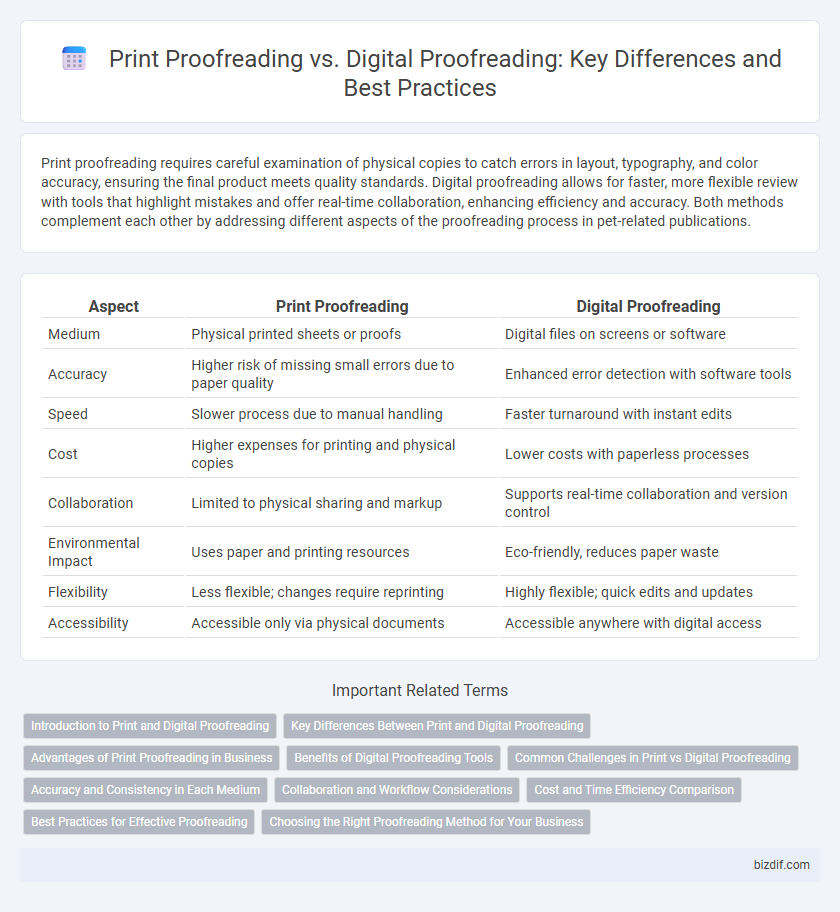Print proofreading requires careful examination of physical copies to catch errors in layout, typography, and color accuracy, ensuring the final product meets quality standards. Digital proofreading allows for faster, more flexible review with tools that highlight mistakes and offer real-time collaboration, enhancing efficiency and accuracy. Both methods complement each other by addressing different aspects of the proofreading process in pet-related publications.
Table of Comparison
| Aspect | Print Proofreading | Digital Proofreading |
|---|---|---|
| Medium | Physical printed sheets or proofs | Digital files on screens or software |
| Accuracy | Higher risk of missing small errors due to paper quality | Enhanced error detection with software tools |
| Speed | Slower process due to manual handling | Faster turnaround with instant edits |
| Cost | Higher expenses for printing and physical copies | Lower costs with paperless processes |
| Collaboration | Limited to physical sharing and markup | Supports real-time collaboration and version control |
| Environmental Impact | Uses paper and printing resources | Eco-friendly, reduces paper waste |
| Flexibility | Less flexible; changes require reprinting | Highly flexible; quick edits and updates |
| Accessibility | Accessible only via physical documents | Accessible anywhere with digital access |
Introduction to Print and Digital Proofreading
Print proofreading involves reviewing physical hard copies for typographical errors, layout issues, and color inconsistencies before mass printing, ensuring accuracy in traditional publishing workflows. Digital proofreading focuses on detecting errors within electronic documents and online content using software tools and screen-based reviews to streamline the editing process. Both methods aim to enhance final output quality but differ in format, tools, and error types addressed.
Key Differences Between Print and Digital Proofreading
Print proofreading involves reviewing physical copies to check for typographical errors, formatting inconsistencies, and color accuracy, ensuring the final product meets quality standards. Digital proofreading focuses on screen-based content, emphasizing hyperlink functionality, digital layout, and resolution clarity across various devices. Key differences include the medium of review--tangible print versus digital display--and the specific error types each format typically encounters.
Advantages of Print Proofreading in Business
Print proofreading provides a tactile experience that enables accurate detection of layout errors, color inconsistencies, and font issues critical to brand integrity in business communications. It facilitates detailed examination of physical proofs, ensuring that printed marketing materials, packaging, and documents meet quality standards before mass production. This hands-on approach reduces costly errors and enhances professionalism, ultimately protecting a company's reputation and customer trust.
Benefits of Digital Proofreading Tools
Digital proofreading tools enhance accuracy by automatically detecting spelling, grammar, and punctuation errors, reducing human oversight. These tools offer real-time editing capabilities and seamless integration with various content management systems, speeding up workflow efficiency. Advanced algorithms in digital proofreaders often include stylistic suggestions and consistency checks that improve overall text quality compared to traditional print proofreading.
Common Challenges in Print vs Digital Proofreading
Print proofreading often faces challenges such as color inconsistencies and layout shifts due to physical printing variations, while digital proofreading commonly struggles with screen resolution differences and interactive content accuracy. Both formats require meticulous attention to text alignment, font consistency, and error detection, but print demands pre-press proof checks, unlike dynamic digital updates. Ensuring content integrity across formats involves understanding their distinct error types and technological limitations to maintain quality and readability.
Accuracy and Consistency in Each Medium
Print proofreading demands meticulous attention to detail due to the static nature of physical proofs, requiring accuracy in font alignment, color consistency, and layout before final printing. Digital proofreading offers dynamic tools such as spell-checkers and automated formatting, enhancing accuracy while enabling quick revisions, but may struggle with consistent color calibration across different devices. Ensuring consistency in print involves manual cross-checking against design specifications, whereas digital proofreading benefits from software that detects inconsistencies in real-time, optimizing accuracy for each medium's unique requirements.
Collaboration and Workflow Considerations
Print proofreading demands precise attention to physical layout and color accuracy, requiring teams to collaborate closely on-site or via high-resolution proofs to ensure final product fidelity. Digital proofreading enhances workflow efficiency by enabling real-time collaboration across remote teams through cloud-based platforms, streamlining revisions and instant feedback. Choosing between print and digital proofreading hinges on balancing tactile validation needs against the speed and flexibility of digital workflows.
Cost and Time Efficiency Comparison
Print proofreading often involves higher costs due to the need for physical materials, printing, and shipping, which can also extend turnaround times compared to digital proofreading. Digital proofreading streamlines the review process by enabling instant edits, collaboration, and distribution, significantly reducing both time and expenses. Organizations aiming to maximize cost and time efficiency typically prefer digital proofreading for its speed and lower operational costs.
Best Practices for Effective Proofreading
Print proofreading requires careful attention to font size, color accuracy, and paper quality to ensure the final physical product meets expectations. Digital proofreading benefits from tools like spell check, track changes, and digital annotations that enhance error detection and streamline collaboration. Combining both approaches with a systematic review process and checklist optimizes accuracy and reduces costly mistakes.
Choosing the Right Proofreading Method for Your Business
Selecting the right proofreading method for your business depends on project scope and output format, where print proofreading ensures color accuracy and layout consistency for physical materials, while digital proofreading excels in verifying hyperlinks, interactive elements, and on-screen readability. Businesses targeting traditional media or high-quality print collaterals benefit from print proofreading to catch formatting and print-specific errors. Conversely, companies focused on web content, eBooks, and digital marketing rely on digital proofreading tools to optimize SEO, user experience, and responsiveness across devices.
Print Proofreading vs Digital Proofreading Infographic

 bizdif.com
bizdif.com